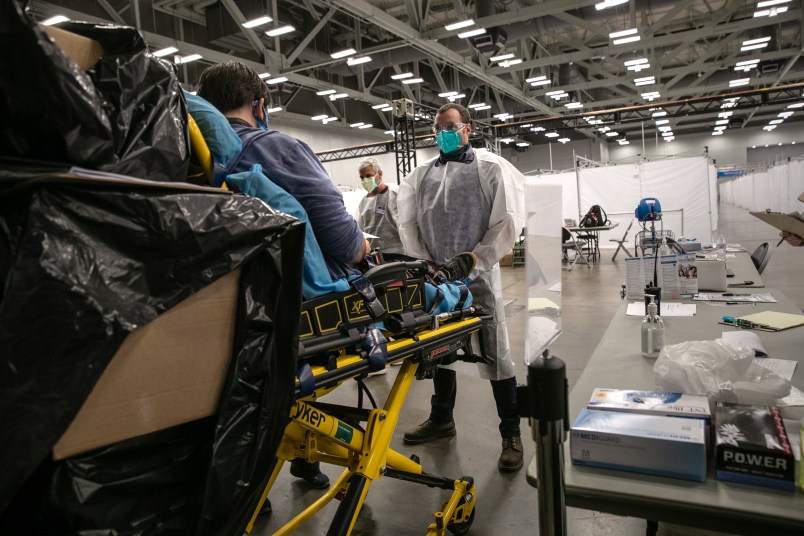Hospitals around the country face a grim winter as COVID-19 cases and hospitalizations surge. It’s shaping up to be a national triage situation.
But many state and local governments, and hospital associations, have planned for what could be reality in a few weeks. That is, what to do when the number of patients far outstrips the ability of a hospital or health care system to treat them?
The upshot is that as numbers continue to grow, the effects of overwhelmed hospitals could stretch far beyond the ward. For example, in some parts of the country, hospitals may not be able to take in those injured from car accidents. In some areas, COVID patients won’t be able to get on oxygen or a ventilator.
Here’s what that may look like in several key states if trends continue over the coming weeks.
Texas
The Dallas County Medical Society has guidelines for triaging patients that north Texas hospitals have been using in the crisis.
- A separate palliative care team created to relieve the pain of those who can’t get full treatment and a triage committee to direct who gets what care
- Doctors start evaluating new patients for criteria that would deny them hospital admission
- Surgeries only performed on those who need it to live or for discharge
California
California developed crisis standards of care guidelines in June for how its hospitals should triage patients amid a total lack of capacity.
- Doctors recommended not to try saving those already dying
- Those most likely to survive get limited oxygen tanks, ventilators
- Family members called upon to provide basic hygiene services to patients
New York City
In late April, weeks after the worst phase of the pandemic had come to an end in the five boroughs, New York City released its crisis standards of care plan. That has since become a model for other local governments and hospital systems as they try to anticipate what is to come.
- A triage officer or committee is activated to decide who receives lifesaving care and who receives palliative care
- Patients on limited “life-saving technologies” re-evaluated at 48 and 120 hours to determine if the plug should be pulled
- Family members may be asked to operate manual oxygen ventilators
North Dakota
North Dakota, stricken by case loads and hospitalization rates that may be showing signs of stabilization, has a plan for triaging a pandemic from years ago.
- Volunteer-staffed minimal care field hospitals set up for pandemic patients
- No attempts to resuscitate people in cardiac arrest, either at a hospital or by paramedics in the field
- Paramedics treat people in the field to prevent additional crowding at emergency rooms
Wisconsin
Wisconsin’s state government committed to creating triage guidelines in March, but as cases dropped off, so did the effort. Instead, the state’s hospital association has a plan for its members to use.
- Expanding bed space to include conference rooms, hallways, outdoor tents
- Patients excluded from treatment based on pre-existing conditions
- Palliative care for those who “altruistically choose to forego treatment”
Florida
The State of Florida has yet to draft crisis guidelines for its hospitals, and instead punted the question to the private sector. The Florida Hospital Association ratified triage guidelines developed by a group of in-state hospitals in April.
- Public health workers given treatment priority
- New patients scored for admission based off of condition of organs, dementia, cancer, and other issues with age as a tiebreaker
- Patients taken off ventilators if their condition gets worse after 48 hours and 120 hours after intubation
Arizona
Arizona’s department of health services has an extremely detailed and comprehensive plan for its crisis standards of care. To date, it’s the only state to have activated its plan.
- Comfort care sites established for patients expected to die
- Scored admission to hospitals based on pre-existing conditions, likelihood of survival
- Triage officers appointed at hospitals to direct patients to ICU or comfort care
Oklahoma
The Oklahoma State Department of Health has a detailed list of triage guidelines for hospitals in the state.
- Staff at laboratories, radiology, testing re-directed to treat patients
- Patients receive smaller doses than needed of medications in shortage, or are asked to take expired medicines
- Look for additional medical equipment like IV hookups at veterinary offices
- Some patients only receive comfort care before death, no effort is made to save them if they’re beyond a certain point
Idaho
Idaho just developed its triage protocols, as cases have been spiking in the state.
- Emergency responders decline 911 calls with no immediate threat to life
- Hospitals only admit patients with a chance of survival
- Palliative care teams of “physicians, nurses, clergy, and lay persons” created to provide for the dying



